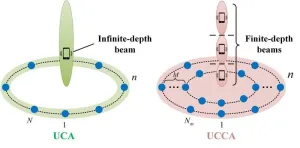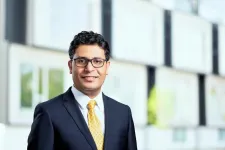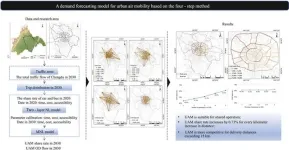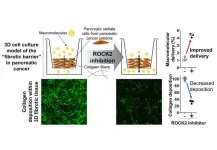(Press-News.org) Highlights:
Dermatophytes are fungi that cause skin, hair and nail fungal infections.
These infections often develop resistance to azoles, a common anti-fungal treatment.
A new study suggests that adding common bone loss drugs to azoles can improve efficacy.
In lab tests, combinations of these drugs worked against dermatophyte species and prevented resistance.
Washington, D.C.—Human skin, hair and nails are all vulnerable to fungal infections. While these infections are usually not serious, they’re difficult to fully resolve and often recur after treatment—sometimes for years. They’re also often resistant to treatments, including a common class of antifungals called azoles.
A study published this week in mSphere points to a new way to boost the efficacy of azoles in treating those infections—combining them with commonly available drugs called bisphosphonates, usually used to treat osteoporosis. Previous work by the same research group has shown that adding bisphosphonates to azoles can effectively treat yeast infections from Candida and Cryptococcus species. The new study extends that finding to dermatophytes, which cause superficial infections.
The study suggests that bisphosphonates could be repurposed to use with azole antifungals, which are relatively nontoxic, and that the combination could be readily tested in clinical studies.
“There aren’t many good antifungal drugs around, and the fungus will always develop resistance no matter how you treat them,” said senior author Dee Carter, a mycologist at the University of New South Wales, Australia. “For what we’re proposing, to use 2 drugs at the same time, that resistance is much less likely.”
Carter says she was only a little surprised to see the synergistic effect in dermatophytes. This research project began years ago, she says, when her group conducted a series of genomic analyses on the response of pathogenic yeasts to drug treatment. That study led them to a genetic pathway that is “upstream” of the pathway targeted by azoles, and is instead targeted by bisphosphonates. “That’s often a good way to get drugs to work, is to target processes that are interlinked like that,” Carter said.
In the lab, Carter and her team tested 3 commonly available bisphosphonates (risedronate, alendronate and zoledronate) in combination with 3 commonly available azole antifungals (fluconazole, itraconazole and ketoconazole). They tested these against clinical isolates from a diverse range of dermatophyte species that cause superficial infections. The combination of zoledronate and ketoconazole proved particularly effective against 8 of the 9 tested species. It also prevented the development of resistance.
Aidan Kane, mycologist, lead author of the study and a Ph.D. student in Carter’s lab, used fluorescence microscopy and other methods to show that the drug combination worked by weakening the cell membrane enough that the fungus could not survive. Beyond the dermatophytes, the group also found that bisphosphonate-azole combinations could act against molds that cause invasive disease, suggesting another possible clinical application for the drugs.
“You can use these combinations directly for superficial infections, like Candida or dermatophyte infections, and we’re hoping that with modified forms of the drugs we can create something that will also work systematically,” Carter said. “The next step is to continue testing bisphosphonate-azole combinations in animal models, and then test it in clinical trials.”
###
The American Society for Microbiology is one of the largest professional societies dedicated to the life sciences and is composed of 36,000 scientists and health practitioners. ASM's mission is to promote and advance the microbial sciences.
ASM advances the microbial sciences through conferences, publications, certifications, educational opportunities and advocacy efforts. It enhances laboratory capacity around the globe through training and resources. It provides a network for scientists in academia, industry and clinical settings. Additionally, ASM promotes a deeper understanding of the microbial sciences to diverse audiences.
END
Bone loss drugs can help azoles fight fungal infections
2024-06-05
ELSE PRESS RELEASES FROM THIS DATE:
Focusing ability enhancement in broadside direction of array: from UCA to UCCA
2024-06-05
Benefits of emerging near-field communications:
The progression of 5G mobile communication commercialization has spurred anticipation for 6G communication. To support emerging applications like digital twins, holographic video, and augmented reality (AR), extremely large-scale antenna array (ELAA) is regarded as key candidates for future 6G mobile communication due to its potential to enhance spectrum efficiency.
“Compared with 5G massive multiple-input multiple-output (MIMO) systems, 6G ELAA not only entails an increase in the number of antennas, but also signifies a fundamental shift in electromagnetic ...
Safer, cheaper, more flexible battery invented for wearable tech
2024-06-05
Researchers have developed a safer, cheaper, better performing and more flexible battery option for wearable devices.
A paper describing the ‘recipe’ for their new battery type was published in the journal Nano Research Energy on June 3.
Fitness trackers. Smart watches. Virtual-reality headsets. Even smart clothing and implants. Wearable smart devices are everywhere these days. But for greater comfort, reliability and longevity, these devices will require greater levels of flexibility and miniaturization of their energy storage mechanisms, which are often frustratingly bulky, heavy and fragile. On top of this, any improvements cannot come at the expense of ...
Case Western Reserve University researchers develop new method of DNA testing—expanding scientific innovation
2024-06-05
CLEVELAND—A team of researchers from the Case Western Reserve University School of Medicine has developed a new method for target DNA sequence amplification, testing and analysis.
This new technique, or reaction, known as AMPLON (Amplifying DNA with Multiarm Priming and Looping Optimization of Nucleic Acid), offers an alternative to the previously accepted “gold-standard” Polymerase Chain Reaction (PCR) method, opening the opportunity for more applications in medical diagnosis.
The team’s findings were recently published in the journal Advanced Materials.
“AMPLON ...
Advancing Urban Mobility: Chengdu's 2030 UAM Forecast
2024-06-05
Chengdu, a bustling city, is on the brink of revolutionizing its transportation landscape by introducing Urban Air Mobility (UAM). A recent study named “A demand forecasting model for urban air mobility in Chengdu, China” conducted by a team of researchers from the Institute of Geographic Sciences and Natural Resources Research, Chinese Academy of Sciences, proposes a sophisticated model to predict the future demand for UAM in Chengdu by 2030.
Urban Air Mobility refers to the use of Electric Vertical Take-Off and Landing (eVTOL) aircraft to transport people and goods across urban areas, potentially easing the notorious ...
Breaking down barriers: ROCK2 inhibition facilitates drug delivery in fibrotic pancreatic cancer
2024-06-05
Pancreatic cancer, recognized as one of the deadliest cancers, poses a persistent challenge for medical professionals globally due to its aggressive behavior and resistance to conventional therapies. The dense fibrotic tissue surrounding pancreatic tumors acts as a significant barrier, hindering the delivery of macromolecular drugs such as antibodies and nanomedicines. Therefore, addressing fibrosis is crucial in enhancing therapeutic outcomes for patients with pancreatic cancer, whose prognosis remains bleak.
Understanding the underlying mechanisms driving ...
Teens with later sleep schedules are less active, eat more carbohydrates
2024-06-05
DARIEN, IL – A new study to be presented at the SLEEP 2024 annual meeting found that circadian misalignment, which is highly prevalent in adolescents, is linked with carbohydrate consumption and sedentary behavior in teens.
Results show that a later sleep schedule was significantly associated with greater intake of carbohydrates, and this relationship was partially explained by irregular sleep timing. A later sleep schedule also was associated with greater sedentary behavior, even after adjusting for variables such as demographics, sleep disorders, and insufficient sleep.
“Delaying sleep schedules is normal during puberty and adolescence; however, some ...
Study reveals that nearly half of foster caregivers have given melatonin to their child
2024-06-05
DARIEN, IL – A new study to be presented at the SLEEP 2024 annual meeting found that it is common for foster caregivers to give melatonin to their child, and these children who have taken melatonin have worse sleep and more daytime behavioral problems.
Results show that 48% of foster caregivers reported administering melatonin to their child. Children given melatonin had poorer overall sleep quality compared to children not given melatonin, yet even after adjustment for sleep quality and other potential confounders, melatonin use was associated with increased severity of daytime behavioral problems in foster ...
Blood sausages and yak milk: Bronze Age cuisine of Mongolian nomads unveiled
2024-06-05
Bronze cauldrons were used by the inhabitants of the Mongolian steppe around 2,700 years ago to process animal blood and milk. This is shown by a protein analysis of archaeological finds from this period.
Scattered across the Eurasian steppe, archaeologists repeatedly come across metal cauldrons from the Bronze Age during excavations. However, it was previously unclear exactly what they were used for. Now, an international study led by researchers at the University of Basel and published in the journal Scientific Reports reveals their secret: Mongolian nomads collected blood ...
Genetics study points to potential treatments for restless leg syndrome
2024-06-05
Scientists have discovered genetic clues to the cause of restless leg syndrome, a condition common among older adults. The discovery could help identify those individuals at greatest risk of the condition and point to potential ways to treat it.
Restless leg syndrome can cause an unpleasant crawling sensation in the legs and an overwhelming urge to move them. Some people experience the symptoms only occasionally, while others get symptoms every day. Symptoms are usually worse in the evening or at night-time and can severely impair sleep.
Despite the condition ...
Scientists detect slowest-spinning radio emitting neutron star ever recorded
2024-06-05
Scientists have detected what they believe to be a neutron star spinning at an unprecedentedly slow rate —slower than any of the more than 3,000 radio emitting neutron stars measured to date.
Neutron stars - the ultra-dense remains of a dead star - typically rotate at mind-bendingly fast speeds, taking just seconds or even a fraction of a second to fully spin on their axis.
However, the neutron star, newly discovered by an international team of astronomers, defies this rule, emitting radio signals on a comparatively ...





